
News
Behind the Headlines
Two-Cents Worth
Video of the Week
News Blurbs
Articles
Testimony
Bible Questions
Internet Articles (2015)
Internet Articles (2014)
Internet
Articles (2013)
Internet Articles (2012)
Internet Articles (2011)
Internet Articles (2010)
Internet Articles
(2009)
Internet Articles (2008)
Internet Articles (2007)
Internet Articles (2006)
Internet Articles (2005)
Internet Articles (2004)
Internet Articles (2003)
Internet Articles (2002)
Internet Articles (2001)

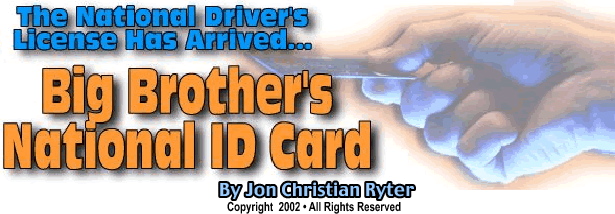
NOTE: When I wrote Whatever Happened To America? I included a chapter in that book dealing with the planned creation of an Internal Passport in the United States by the Clinton White House. The deep research for that book began in July,1996. On January 17, 1997, I interviewed Allen Kay, the press secretary for Congressman Lamar Smith [R-TX] by telephone to refute or confirm the substance found in a White House protocol dated November 11, 1993 that was in my possession.
In that telephone interview Kay admitted that there were efforts, on three occasions during the floor debate on H.R. 220 to initiate what Smith's office referred to as the "national identity card dialogue." Kay said that Smith, who drafted the legislation that would become known as Public Law 104-298, saw no need for such extreme measures and successfully thwarted efforts to introduce what amounted to an internal passport into the Immigration Reform Act of 1996. In reality, not only did Lamar Smith not fight to thwart efforts on the part of the Democrats to introduce an internal passport into the Immigration Reform Act of 1996, Smith actually led the covert effort to insert it after the American people discovered that Congress was attempting to create a law that would force Americans to carry a biometric National ID Card. The card was being implemented on a global scale to control a population which President Bill Clinton said was "...too highly mobile."
If you have not read Whatever Happened To America? you need to read it before the midterm election. Several Republican members of Congress joined with key House and Senate Democrats to secretly insert a national identity card into the House Omnibus Budget Bill of 1996 after a coalition that included the American Civil Liberties Union, Free Congress Foundation, the CATO Institute and Christian Coalition discovered an internal passport had been included in both the House and Senate versions of that bill.
The Senate hurriedly passed their version—with the internal passport attached. When the public learned that there was an internal passport—disguised as a national drivers' license—included in the House version, public indignation rapidly escalated and, due to the efforts of the advocacy groups mentioned, the House was forced to discard the internal passport from their own version of the Immigration Reform Act.
When the Immigration Reform Act went into Joint Conference, the national drivers' license—which had only been passed by the Senate—remained in the bill that was sent to the White House. Bill Clinton signed Òhalf-a-driverÕs licenseÓ into law. Hidden in the voluminous text of the Omnibus Budget Bill of 1996 which was sent to the White House a month later was the House version of the national drivers' license.
The third element needed for the new biometric internal passport was the 24-digit personal identifier which was buried in the Healthcare Portability Act of 1997. The personal identifier is an internal identification number. Every person in the world will have their own unique personal identifier. Unlike the Social Security Card which does not have an infinite supply of numbers and is now recycling numbers that had formerly been assigned to people who are now deceased, the personal identifiers are infinite. And, where government officials were banned from using the Social Security Card as an identification card by the Social Security Act of 1934 itself, the national ID card (or national driversÕ license, or more precisely, the internal passport that every person in the world will be forced, by law, to carry) not only is an identification card, it is a biometric card that will include your personal life history, including all of your personality "warts" for any law enforcement agency, or anyone else in authority to access.
As the United States begins the task of implementing what the federal government is now calling a State-initiated program to upgrade driversÕ licenses with SmartCard™ technology that contains an information database on each license-holder, the media is adroitly concealing the fact that the effort to use SmartCard technology did not originate as a solution to September 11 as the American people were led to believe. The effort to create a biometric internal passport (first disguised as a national healthcare card and later as a national drivers' license) was first postulated in the Clinton White House on November 11, 1993.
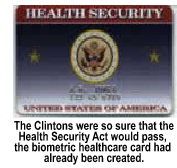 The
co-presidency of Bill and Hillary Clinton realized that Hillary's socialized healthcare plan—which would have nationalized
1/7th of the American economy—could not be enacted even by a very
liberal Democratically-controlled Congress. When the Clintons realized that nothing was going to save HillaryÕs nationalized
healthcare plan which contained a very complex system designed not to
provide Canadian-style healthcare services, but to spy on the American
people through a very complex system that utilized both GPS and ground
monitoring systems with biometric chips embedded in the healthcare cards
The
co-presidency of Bill and Hillary Clinton realized that Hillary's socialized healthcare plan—which would have nationalized
1/7th of the American economy—could not be enacted even by a very
liberal Democratically-controlled Congress. When the Clintons realized that nothing was going to save HillaryÕs nationalized
healthcare plan which contained a very complex system designed not to
provide Canadian-style healthcare services, but to spy on the American
people through a very complex system that utilized both GPS and ground
monitoring systems with biometric chips embedded in the healthcare cards
Each drivers' license would contain a computer chip that not only detailed your driving history but your credit and medical history as well—and whether or not you have ever been arrested. In fact, it would even include whether or not you were a "suspected extremist." The industrialized nations in the Europ were already doing it. The European Union had been trying to figure out how to force their own citizens to accept what amounts to an Internal Passport that will allow government to both monitor and control their activities.
It should be noted that when news surfaced that the States were obligated to implement the biometric national drivers' license that the Clinton National Highway Transportation Safety Administration [NHTSA] tried to implement through regulatory means in 1998, the media immediately begin to take shots at the conservatists who originally alerted America to the fact that the national drivers' license will contain a computer chip that can track any cardholder in the world, poophahing the notion that the nationalized driversÕ license would contain a tracking chip by asserting that such technology was not yet feasible. ÊÊÊÊÊ
In 1998 the Clinton Department of Health and Human Services [DHHS] initiated a Òhealthcare program testÓ in five western States that was not authorized by Congress, nor was it funded by the federal government (since Congress would have had to approve funding). And, of couse, that alsom meant the general public wouldhave learned the details about the "Big Brother experiment" funded with their tax dollars. The funding for this special project came from the Robert Wood Johnson Foundation.
Low income
women with dependent children in the test area were provided with a
biometric Health Passport Card (the actual card is pictured here).
The entire medical history of the benefits recipients was stored in
a 1 megabyte chip that was embedded in the card. 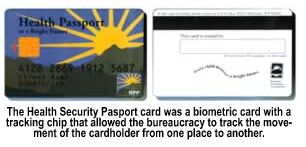 In
addition, recorded on the card was the vaccine history of each benefits
recipient. Based on the assumption that low income people are far more
transient than stable, middle income households, one other element was
added to the Health Passport card: a GPS tracking chip that contained
the personal identifiers of the benefits recipient was included.
In
addition, recorded on the card was the vaccine history of each benefits
recipient. Based on the assumption that low income people are far more
transient than stable, middle income households, one other element was
added to the Health Passport card: a GPS tracking chip that contained
the personal identifiers of the benefits recipient was included.
Starting in 1997 with the passage of the Healthcare Portability Act of 1997, every American has been assigned a 24-digit personal identifier. (When you filed your census report in 2000, the 24-digit tracking code on your 2000 Census form was your unique personal identifier. All of the public relations hyperbole that accompanied the 2000 census suggested that Americans had complete anonymity in filing, noting that neither the respondent's name or Social Security was required on submission. In point of fact, the tracking code on the form was that taxpayer or head-of-householdÕs personal identifier. Big Brother knew the identity of every person in America who submitted the form they received in the mail.
In the summer of 1999, DHHS held a follow-up conference in Denver, Colorado to report on the progress of the Robert Wood Johnson Foundation funded test. It was a huge success. As the senior-level Clinton Administration healthcare executives watched the big screen TVs that were conveniently positioned around the room, they were shocked and amazed to see a thousand points of light appear on the screens. Each speck of light, they were told, represents one benefits recipient. Each speck, they were told, was being tracked by GPs The televisions zoomed in from the five state map first to one state, then one county, one community, and then one zone within that community. The DHHS, the attendees were told, had the ability to track each recipient wherever they moved—to make certain that their children were receiving whatever vaccinations they required whenever needed.
George Orwell's Big Brother had finally arrived in the form of a grand gratuity. He was a half century late. America's politicians learned long ago that if you gift wrap it in glittery red, white and blue foil and package it in a large enough box, Americans will gleefully accept any abrogation of their rights in exchange for a handout at the taxpayer's expense—never realizing that they are the ones footing the bill.
The creation of the proposed internal passport was discussed extensively in a White House strategy meeting on November 11, 1993 when it appeared that the Clinton Health Security Act was not going to be enacted by the Democratically-controlled Congress (which had just passed the largest tax increase in history and was already worried about getting reelected a year later. (The entire protocol is recorded, word-by-word, in my book, Whatever Happened To America? The Clinton Administration discussed concealing their internal passport in a bill ostensibly designed to keep illegal immigrants from stealing jobs from hardworking Americanswho were already being targeted for "job removal" by NAFTA. That bill, of course, was the Immigration Reform Act of 1996.
While nobody in either the House of Representatives or the United States Senate questioned how you can constitutionally declare a piece of legislation passed when the House and Senate bills were not only not the same type of fruit, but didn't come from the same kind of tree. Legislation that was not legally signed into law after being enacted in the same legislation and surviving Joint Conference. The Clinton NHTSA attempted to force the States to implement it by decree in July, 1998 was an unconstiuttional farce since the House and Senate versions of that bill came from entirely different pieces of legislation..
Then the Clinton Administration decided to lowball the estimated cost of the program so that, under the terms of the Unfunded Mandates Reform Act of 1996, Clinton could force the States to foot the bill for the program's implementation. Under the Unfunded Mandates Reform Act the States could not be forced to pay for legislation enacted by Congress if the national cost exceeded $100 million.
In order to lowball the cost, the NHTSA built their cost projections based on the projected costs of 5 sparsely populated States: Delaware, Iowa, Montana, Utah and Wisconsin.. The NHTSA claimed they represented a national average.Of course, the Clinton people ignored the heavily populated all of the industrialized States. Florida's estimated cost to implement NHTSA-98-3945 at slightly over $31 million. The cost of implementation by New York, Michigan, California and Illinois alone was over $200 million.
When Congressman Bob Barr [R-GA], Dr. Ron Paul [R-TX] and Mac Collins [R-GA] initiated legislation to abolish the provisions of law that would grant the NHTSA the authority to create a national drivers' license, they knew they didn't have the votes to even get it out of committee.What they expected to do was keep the issue fresh in the public's eye and force Congress to readdress the National ID card in the public arena where it would be soundly defeated.
However what Barr and Paul were trying to do was tantamount to trying to rewrite a movie script after the movie aired in the movie theaters. The barn door was open and the cows had already gone to pasture.
With the public aroused in July, 1998 two months from the midterm elections Barr, Paul and Collins launched a two-prong attack against the national ID card. First, they introduced an amendment to a pending transportation bill to defund the NHTSA's ability to push the program through the States. And second, they demanded a public hearing to secure a one-year moratorium on implementation of the smart card—ostensibly so that the House and Senate could pass legislation to kill the national drivers' license. Barr then went to then House Speaker Newt Gingrich (who was part of the Congressional and Senatorial coalition of senior level Congressmen and Senators responsible for burying the national ID card in the Omnibus Budget Bill of 1996) and threatened to take their allegations of his participation in the scheme to create an internal passport public on conservative talk radio if Gingrich did not back their effort to debate the national ID card in the public arena.
On August 4, 1998 a meeting was held in the office of the Transportation Subcommittee chaired by Frank Wolf [R-VA]. Attending also that was Congressman Lamar Smith who originated the National Drivers' License legislation. Smith, angered by Barr, lobbied not only Gingrich but House Majority Leader Dick Armey to put Barr and Ron Paul back in their places. "Push" finally gave way to "shove" and Smith had all the congressional weight on his side. As Barr pushed for his moratorium, Smith frantically pushed Transportation Subcommittee Chairman Wolf to exclude Barr's amendment from the legislation before sending the bill to the floor. On October 6, a month from the midterm elections, Smith secured an agreement from Gingrich to exclude Barr's amendment. As America slept that night Barr, Paul and Collins fought Smith, Wolf and Gingrich. Finally Barr pulled House Whip Tom DeLay and several other conservative House members into the fray. Those House members openly questioned Gingrich why it was that Smith was zealously pushing for something that the American people so vehemently opposed.
Delay, whose power base had grown immensely since 1994, together with Barr, threatened to take the issue to the talk shows the following day. Fearful of voter backlash against the Republicans—and, in particular, himself—Gingrich caved before the morning of October 7. The National DriverÕ' License was suspended in legislative limbo even though Barr's moratorium only postponed the biometric drivers' license for one year. The Clinton-Gore Administration knew that any attempt on their part to implement a biometric national ID card (regardless what it was disguised as) would be met with fierce resistance. As the US version of a national drivers' license vanished into utopian limbo so did the European version which had already been approved by most of the European parliaments. They returned to the political closet to await a more appropriate time, when the fear of dying would overwhelm the people's fear of government.
Silent
Intrusion
A Nixon Administration Social Security task force explored the notion of expanding the Social
Security number into a personal identifier in 1971 under its own rule-making
provisions. In 1973 Nixon's Health, Education & Welfare Secretary's
Advisory Committee concluded that the American people would soundly
reject the expansion of the Social Security card into a national identity
card. Nixon backed off.
In 1976, outgoing President Gerald Ford revisited the internal passport concept. The Federal Advisory Committee on False Identification insisted that changing the social security card into a national identification card was necessary because of the ease in which Americans could change their identity to escape debt obligations or to evade law enforcement officers. To prove their case, the Social Security Administration began to publicize the most abused Social Security number in American history—078-05-1120—the number assigned to Hilda Whitcher.
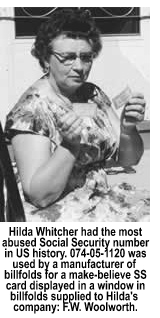 Whitcher was the secretary of F.W. Woolworth Vice President and Treasurer Douglas Patterson. In 1938 F.W. Woolworth signed a contract
with E. H. Ferree, a billfold manufacturer to provide Woolworth
with billfolds. Ferree decided to include a mockup of a social
security card in the wallet to show how the card would look in the wallet. Patterson thought it would be clever to use the actual social
security number of his secretary on the card—which was half the
size of an actual card. The dummy card was printed entirely in red ink,
and contained the word "specimen" across the card.
Whitcher was the secretary of F.W. Woolworth Vice President and Treasurer Douglas Patterson. In 1938 F.W. Woolworth signed a contract
with E. H. Ferree, a billfold manufacturer to provide Woolworth
with billfolds. Ferree decided to include a mockup of a social
security card in the wallet to show how the card would look in the wallet. Patterson thought it would be clever to use the actual social
security number of his secretary on the card—which was half the
size of an actual card. The dummy card was printed entirely in red ink,
and contained the word "specimen" across the card.
In the peak
year of 1943 alone, 5,755 people were using Hilda Whitcher's
social security number. In all, over 40,000 people have used WhitcherÕs
social security number since it was issued in 1936. In 1943 the Social
Security Administration voided the number and placed a "flag"
on its use. Whitcher was issued a new number that year. When
the abuse of her social security number became rampant, the FBI showed
up at her door to grill her on how her number was being used by so many
people. 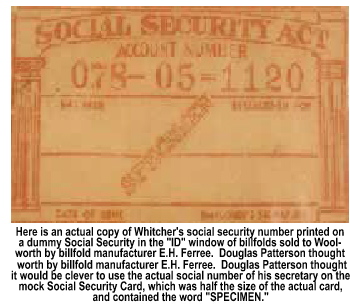 Whitcher told the FBI that after the "specimen" appeared in the Woolworth wallet, people just started "...using the number. They thought
it was their own. I can't understand how people can be so stupid. I
can't understand that." In reality, the 40,000 people who used Hilda Whitcher's social security number did not think F.W.
Woolworth had issued them a new social security card.
Whitcher told the FBI that after the "specimen" appeared in the Woolworth wallet, people just started "...using the number. They thought
it was their own. I can't understand how people can be so stupid. I
can't understand that." In reality, the 40,000 people who used Hilda Whitcher's social security number did not think F.W.
Woolworth had issued them a new social security card.
They were realists who viewed America's grand largess in the same light as Germany's Social Security program—the "benefit" card issued by the Weimar Republic became the internal passport of the Third Reich. The Nazis initially used the internal passport to control the movement of its population, and then used it to round up its undesirables: the Jews, the gypsies, the homosexuals and its political dissidents. Germany was the first nation in the world to provide retirement insurance for its elderly. And, Germany was the first nation to abuse the benefits card that was issued to every German citizen. There was no reason for the American people to believe that, somewhere down the road to Utopia, their own government would not abuse the database they had created on their own population. Shocking as it may seem, even after the Social Security Administration voided 078-05-1120, and flagged the number, 12 people were found to be using the number as late as 1977.
Had President Gerald Ford been elected to the office he was holding by appointment in 1976 it is likely that Congress would have modified the Social Security numbering system at that time, creating a national identification card. In 1977 newly elected President Jimmy Carter who viewed the proposed national idenfitier as "the mark of the beast," told Congress in the most emphatic terms that the Social Security number would never become a personal identifier on his watch. Ronald Reagan's CFR advisors tried in 1981. Reagan told his advisors—and Congress—that he was "explicitly opposed" to the creation of a national ID card.
On November 11, 1993, with the Clinton Health Security Act dying in the Congress, Bill and Hillary Clinton, Ira Magaziner, Thomas "Mack" McLarty, Roy Neel, Gene Sperling, and Richard Herget where involved in a very private White House discussion on how to insert a national ID card into an immigration bill, concocting the spin that an internal passport was necessary to keep illegal aliens from stealing jobs from Americans. As the structure of world government was being formalized in Brussels, the need for a universal, global identifier was becoming more and more imperative imperative to the utopians who felt the need to control the world's human chattel.
The Clintons were assigned the task of making it happen. The leadership of Congress in both parties did their job and, with sleight of hand, created the platform for the internal passport through what would become a national drivers' license. Then, hawking the right of Americans to "...take their healthcare insurance with them when they moved from job to job," Congress passed the Healthcare Portability Act of 1997 and surreptitously created the personal identifier. Finally, after 26 years of secret plotting, the utopians had their internal passport.
After letting the National Drivers'' License lie dormant for two years, the Clintons moved on June 16, 1998. Through its rule-making provisions, the Department of Transportation implemented a rule mandating that all States issue new smart card drivers' licenses. The cards would utilize the new personal identifiers and would contain a computer chip with a 2 megabyte storage capacity. Disputed is whether or not the uniform driversÕ licenses would also contact a GPs tracking chip.
It was the effort that Bob Barr, Ron Paul, Mac Collins and Tom Delay (with the help of several other conservative Congressmen) shut down. It was suddenly a hot potato that Clinton did not want to touch again—at least not until he could no longer run for the presidency. Although the Clintons got closer than any president before them, the Hillary Clinton originated internal passport died on the vine.
The security spin began long before the dust settled over the collapsed twin towers of the World Trade Center on Sept. 11, 2001 and before the flames were extinguished at the Pentagon. America was vulnerable. For the first time since the Cuban Missile Crisis, America was afraid. And as Congress learned long ago, fear is a powerful catalyst for change. Frightened people will more quickly surrender liberty for security than people who feel secure.
The media took up the issue of identifying those who would harm us. The American people were being told by the media that if the government been been able to identify the terrorists who took over two American Airlines and two United Airlines flights before they boarded those planes, they could have stopped them. Yet, even as the media was clamoring for a high tech system to identify potential terrorists, the same media was accusing the government of using racial profiling to single out Muslims as they attemtped to ferret out the Islamic terrorists trying to destroy Amerca.
On November 19, 2001 President George W. Bush—the fifth president to try to create a national identity card—signed the Aviation and Transportation Security Act into law. Like Roosevelt, Nixon, Ford and Clinton, Bush-43, the most admired and trusted President since ReaganÑwas now taking a shot at creating a "user-friendly" internal passport.Authorized by the aviation security bill, the Department of Transportation rapidly moved forward with plans to establish a biometric national transportation-workers identity card that would utilize either an iris scans or digital fingerprints to identify airport workers. The Bush-43 Administration believed that there would be less resistance to a biometric identity card in the general population if one was already being used without adverse affects in the business world. Plans were already underway to create a biometric Trusted Traveler™ card that could be used by frequent flyer airline passengers to bypass the lengthening crowds and long waits at airports. Trusted Traveler™ cards would allow those carrying them to circumvent the extensive screening at airport checkpoints.
Contained on the smart card that would be issued to frequent flyers who had passed a rigorous FBI background check, would be a database on the cardholder that would contain far more information than that person's travel habits. Included would be any criminal history, including misdemeanor traffic violations, and the cardholder's medical history (ostensibly so that if a medical emergency arose in midflight that the attendants would know what pre-existing medical conditions existed and could offer first aid to the passenger). The card would contain a digital image of the cardholder, including an iris scan and fingerprint. The encoded biometric description would ensure that the person carrying the card was the same person identified on the card. Eventually, according to the DOT, biometric travel cards will be used on all domestic and international flights.
When the DOT announced that they were considering a biometric trusted traveler card, Barry Steinhardt, the Associate Director of the American Civil Liberties Union (which has worked closely with the Free Congress Foundation and the CATO Institute to kill anything that even smelled like an internal passport) insisted that "...this is a backdoor national ID. This so-called trusted passenger card will become essentially mandatory for everyone to use not only on airlines but also buses, trains and perhaps cars that drive over bridges and tunnels. The consequences of not having a trusted passenger card is that you will be immediately suspect." Steinhardt insisted that the biometric card posed additional privacy risks from identity theft, inaccurate information being encoded on the cards, and foreign governments receiving data on political refugees as the United Nations becomes the caretaker of the identity database worldwide.
The DOT draft, developed by the Credentialing Direct Agency Group predicts a much more universal application of the cards beyond the initial Trusted Travelerª concept. Initially, the biometric identity card "...would apply to any person who has unescorted access to a transportation facility or who has access to control of a transportation conveyance." The CDAG is a quasi-official task force of the National Infrastructure Security Committee that was put together by Bush Transportation Secretary Norman Y. Mineta within weeks of the September 11 attack.
Today, all of the players from the Clinton-era attempt to create a biometric internal passport are once again hawking the merits of a biometric identification system that, by using digital images, iris scans and digital fingerprints, will help identity potential terrorists and stop them before they are able to launch another attack against the infrastructure of the United States. And the stalwart conservatives who so diligently fought Clinton's attempt to create an internal passport are surprisingly silent.
Their argument now appears to be that what is happening now is not, nor will it lead to, a national ID card. Their argument is weak at best, suspect at worst. Acting on instructions from Congress—this time in the light of day—the Bush Transportation Department began initiating Clinton's failed biometric identity card. But now, under the guise of preventing more threats of terrorism against the people of the United States, the American people were now, for the moment, too afraid to protest.
Once again, the onus was on the States to create a uniform electronic smart card drivers' license that can be checked instantly through a national database that will contain digital images of each license holder as well as iris scans and digital fingerprints—each of which will utlimately become "voluntary options" on your local drivers' licenses in every State. Standardized drivers licenses would mean that every State trooper, county sheriff or local police officer would find the same data in the same place on every drivers license they look at, or scan in the portable scanner that will be in every police cruiser in the nation.
According to the liberal media, for terrorists on the run (and other criminals, too), biometric ID cards are the answer to catching not only terrrorists, but other criminals on the run as well. And, they claim, they will also catch those who engage in identity theft.
It might if those vulnerable to being caught when they used them actually used them. But I suspect that in a biometric world, terrorists and criminals in general will travel as they do now—very covertly. There are well over 100 thosuand illegal Islamic fundamentalists in the United States at this moment. Most of them are holding down jobs of some type—perhaps where you work. They travel freely throughout the United States without State-issued identification. They will continue to do so—perhaps with more difficulty, but they will continue to do so nevertheless.
It's important for the American people to understand that, political rhetoric aside, identification systems, biometric or otherwise, were not designed to catch criminals or terrorists since criminals and terrorists will not register for the ID cards. And, because they won't register, they will avoid those forms of travel that would catch them. That's why the illegal aliens—Islamic, Hispanic, Asian, African or whatnots among us have remained invisible in a society in which they as highly visible.ID systems are created to monitor, and control, the whereabouts of the nation's legal, national citizens.
The utopian liberals insist that the use of a biometric identity card is no longer a "1984-issue." To them, it is an issue of security—and security only. The fight against the use of a national ID card continues, but the fight is much more low key than it was in 1998. Its almost like the conservative zealots have lost their drive to defend liberty. Since November, 2002 several nations have passed laws mandating that their citizens carry a national identity card—and making it a crime if you leave home without it.
But as the liberals insist that the proposed biometric card will never become an internal passport, they argue that it may be necessary to expand its use beyond the transportation industry. It could be necessary, they argue, for a watchful society to implement a more stringent use of the card in order to catch potential terrorists who still need to eat (thus using the swipe card in supermarkets and restaurants), or have a place to sleep at night (thus forcing hotels, motels and apartment leasing companies to verify identifies).
Clearly when world government is formed and a universal cyber-currency is implemented, the use of a biometric ATM debit/credit card will become mandatory. At that time, no person in the world would be allowed to buy or sell anything without having a biometric identity card that verified who they were.

Copyright © 2009 Jon Christian Ryter.
All rights reserved.


